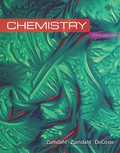
(a)
Interpretation: The structures of the final products formed in the following reactions are to be stated.
Concept introduction: Organic compounds are synthesized through organic reactions. The different types of reactions in
To determine: The structure of
(a)
Explanation of Solution
Explanation
The structure of
The structure of

Figure 1
The given reactant is
(b)
Interpretation: The structures of the final products formed in the following reactions are to be stated.
Concept introduction: Organic compounds are synthesized through organic reactions. The different types of reactions in organic chemistry are elimination reaction, substitution reaction, addition reactions and many more. Addition reactions are takes place when two or more reactants combine to form a single product. Elimination reactions occur when a reactant broke down into two or more products and the substitution reactions takes place by an exchange in the reactants.
To determine: The structure of
(b)
Explanation of Solution
Explanation
The structure of
The structure of
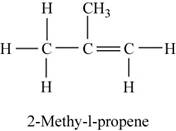
Figure 2
The given reactant reacts with water to form tertiary alcohol as the major product. As tertiary alcohols are formed by the dehydration of
(c)
Interpretation: The structures of the final products formed in the following reactions are to be stated.
Concept introduction: Organic compounds are synthesized through organic reactions. The different types of reactions in organic chemistry are elimination reaction, substitution reaction, addition reactions and many more. Addition reactions are takes place when two or more reactants combine to form a single product. Elimination reactions occur when a reactant broke down into two or more products and the substitution reactions takes place by an exchange in the reactants.
To determine: The two possible structures of
(c)
Explanation of Solution
Explanation
The two possible structures of
The two possible structures of
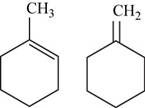
Figure 3
The given chemical formula is
(d)
Interpretation: The structures of the final products formed in the following reactions are to be stated.
Concept introduction: Organic compounds are synthesized through organic reactions. The different types of reactions in organic chemistry are elimination reaction, substitution reaction, addition reactions and many more. Addition reactions are takes place when two or more reactants combine to form a single product. Elimination reactions occur when a reactant broke down into two or more products and the substitution reactions takes place by an exchange in the reactants.
To determine: The structure of hydrocarbon reacted with
(d)
Explanation of Solution
Explanation
The structure of hydrocarbon is shown in Figure 4.
The structure of hydrocarbon is,
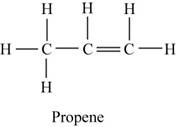
Figure 4
The given hydrocarbon reacts with water which is further oxidized to give acetone. Therefore, the given hydrocarbon should be alkene which is propene as the major product is
(e)
Interpretation: The structures of the final products formed in the following reactions are to be stated.
Concept introduction: Organic compounds are synthesized through organic reactions. The different types of reactions in organic chemistry are elimination reaction, substitution reaction, addition reactions and many more. Addition reactions are takes place when two or more reactants combine to form a single product. Elimination reactions occur when a reactant broke down into two or more products and the substitution reactions takes place by an exchange in the reactants.
To determine: The possible structures for
(e)
Explanation of Solution
Explanation
The first possible structure for
The first possible structure for
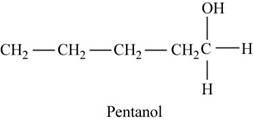
Figure 5
The major product for this reaction is
The second possible structure for
The second possible structure for
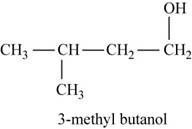
Figure 6
The isomer for the given reactant
The third possible structure for
The third possible structure for
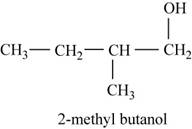
Figure 7
The isomer for the given reactant
The fourth possible structure for
The fourth possible structure for
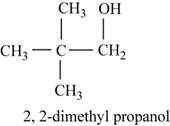
Figure 8
The isomer for the given reactant
Want to see more full solutions like this?
Chapter 22 Solutions
EBK CHEMISTRY
- Design experiments in UV-Vis to figure the optimal mole ratio of copper (1:1, 2:1, 3:1 and etc)versus ethambutol using all necessary chemicals including dihydrochloride and copper nitrate hemipentahydrate and sodium hydroxide. Show how UV-Vis absorbance and maximum wavelength would change in responsearrow_forwardCorrect each molecule in the drawing area below so that it has the condensed structure it would have if it were dissolv a 0.1 M aqueous solution of HCI. If there are no changes to be made, check the No changes box under the drawing area. No changes. HO—CH,—C—CH,—OH X 5 2 2 2 HO–CH,—CH,—C—CH,—OH Explanation Check Center Accessi ©2025 on 5 Carrow_forwardMake the calculations to prepare 2M H2SO4, from concentrated H2SO4 (98%; density: 1.84 g/mL).arrow_forward
- H CH3 CH3 b) Write the products of your compound and the following reagents. If the reaction would not work for your compound, write "no reaction" and explain the problem. NaCN H* H₂NNHCH5 H* -à NaBH -à CH2MgBr Cro₁₂ --à H3O+ -à c) Would your compound give a positive Tollen's test? Why or why not?arrow_forwardHomework 4 Chem 204 Dr. Hellwig Consider this compound, which will be referred to as "your compound". a) Name your compound according to the IUPAC system. Include stereochemistry (E/Z/R/S) H CH3 CH3arrow_forwardWhat is the mechanism for this?arrow_forward
- 21.50 Determine the combinations of haloalkane(s) and alkoxide(s) that could be used to synthesize the following ethers through Williamson ether synthesis. (a) (c) (d) (e) (f) H₂COarrow_forward1. Arrange the following in order of increasing bond energy (lowest bond energy first, highest bond energy last). Provide your rationale. C=C, C-F, C=C, C-N, C-C List the bond order for each example.arrow_forwardWhat is the major enolate formed when treated with LDA? And why that one?arrow_forward
- 4. Calculate the total number of sigma bonds and total number of pi bonds in each of the following compounds. a. HH :D: +1 I H-N-C-C-O-H I H b. HH H Н :N=C-C-C=C-CEC-H :0: total o H-C-H H-C = `C-H I H. 11 H-C = C= CH H total o total π total π 1 Harrow_forwardIn the following reaction, what quantity in moles of CH₃OH are required to give off 4111 kJ of heat? 2 CH₃OH (l) + 3 O₂ (g) → 2 CO₂ (g) + 4 H₂O(g) ∆H° = -1280. kJarrow_forwardIndicate the processes in the dismutation of Cu2O.arrow_forward
 ChemistryChemistryISBN:9781305957404Author:Steven S. Zumdahl, Susan A. Zumdahl, Donald J. DeCostePublisher:Cengage Learning
ChemistryChemistryISBN:9781305957404Author:Steven S. Zumdahl, Susan A. Zumdahl, Donald J. DeCostePublisher:Cengage Learning Chemistry: An Atoms First ApproachChemistryISBN:9781305079243Author:Steven S. Zumdahl, Susan A. ZumdahlPublisher:Cengage Learning
Chemistry: An Atoms First ApproachChemistryISBN:9781305079243Author:Steven S. Zumdahl, Susan A. ZumdahlPublisher:Cengage Learning
 General Chemistry - Standalone book (MindTap Cour...ChemistryISBN:9781305580343Author:Steven D. Gammon, Ebbing, Darrell Ebbing, Steven D., Darrell; Gammon, Darrell Ebbing; Steven D. Gammon, Darrell D.; Gammon, Ebbing; Steven D. Gammon; DarrellPublisher:Cengage Learning
General Chemistry - Standalone book (MindTap Cour...ChemistryISBN:9781305580343Author:Steven D. Gammon, Ebbing, Darrell Ebbing, Steven D., Darrell; Gammon, Darrell Ebbing; Steven D. Gammon, Darrell D.; Gammon, Ebbing; Steven D. Gammon; DarrellPublisher:Cengage Learning Introductory Chemistry: A FoundationChemistryISBN:9781337399425Author:Steven S. Zumdahl, Donald J. DeCostePublisher:Cengage Learning
Introductory Chemistry: A FoundationChemistryISBN:9781337399425Author:Steven S. Zumdahl, Donald J. DeCostePublisher:Cengage Learning World of Chemistry, 3rd editionChemistryISBN:9781133109655Author:Steven S. Zumdahl, Susan L. Zumdahl, Donald J. DeCostePublisher:Brooks / Cole / Cengage Learning
World of Chemistry, 3rd editionChemistryISBN:9781133109655Author:Steven S. Zumdahl, Susan L. Zumdahl, Donald J. DeCostePublisher:Brooks / Cole / Cengage Learning





